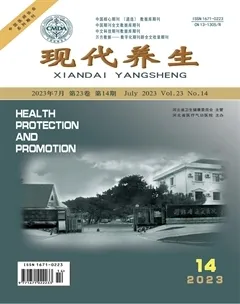免疫炎癥指標與心血管疾病關系的研究進展
【摘要】" 心血管疾病(cardiovascular disease,CVD)是影響全球5億成年人的主要健康問題,盡管CVD的診斷和治療策略已經有了相當大的改進,但CVD的患者和費用仍在增長。炎癥在CVD的發生和發展過程中發揮著重要作用。由于血液學炎癥指標具有價格低廉、容易獲得,廣泛可用等優點。將對多種免疫炎癥指標包括白細胞計數(white blood cell,WBC)及其亞型、中性粒細胞與淋巴細胞比值(neutrophil to lymphocyte ratio,NLR)、血小板與淋巴細胞比值(platelet to lymphocyte ratio,PLR)、單核細胞與淋巴細胞比值(lymphocyte to monocyte ratio,LMR)、全身免疫炎癥指數(systemic immune-inflammation index,SII)、系統炎癥反應指數(system inflammation response index,SIRI)與CVD的研究進展進行綜述。
【關鍵詞】" 免疫炎癥;血液學;心血管疾病;預測;預后
中圖分類號" R54" " 文獻標識碼" A" " 文章編號" 1671-0223(2023)14--04
隨著全球經濟的發展和老年人群比例的增加及不良生活習慣流行,心血管疾病(cardiovascular disease,CVD)的患病率急劇上升,并已成為世界首位死亡原因[1]。已有證據表明,免疫炎癥反應參與了CVD的發生、發展[2],免疫炎癥指標反映機體對刺激的防御狀態,炎癥標志物的增加與各種心血管事件的聯系已經建立起來[3-5]。一些前瞻性研究表明,一些廉價且易于獲得的血液學炎癥指標包括白細胞計數(white blood cell,WBC)、中性粒細胞與淋巴細胞比值(neutrophil to lymphocyte ratio,NLR)、血小板與淋巴細胞比值(platelet to lymphocyte ratio,PLR)、單核細胞與淋巴細胞比值(lymphocyte to monocyte ratio,LMR)、全身免疫炎癥指數(systemic immune-inflammation index,SII)、系統炎癥反應指數(system inflammation response index,SIRI)等,均可作為CVD風險的預測及預后因子[2,4,6-10]。在各種臨床情況下,不同免疫炎癥指標的預測及預后效用各不相同,本文將進一步探討多種免疫炎癥指標(WBC及其亞型、NLR、PLR、LMR、SII、SIRI)與CVD在疾病預測、診斷及預后過程中的作用,從而更好地用于指導臨床實踐。
1" WBC及其亞型
免疫反應和炎癥的最簡單,也是最常測量的標志物之一是WBC計數。研究報告WBC計數升高是CVD的獨立危險因素和預后指標[2,11-15]。在納入93676名絕經后美國婦女的婦女健康倡議觀察性研究中,高WBC計數(gt;6.5×109/L)的總死亡率和冠心病(coronary heart disease,CHD)死亡的風險增加[12]。北曼哈頓的一項研究[14]納入了3103名無卒中多種族社區參與者,WBC計數每升高1個標準差(standard deviation,SD)即(1.8×109/L),缺血性卒中的風險增加22.0%,總卒中的風險增加19.0%。
有研究顯示中性粒細胞計數在預測CVD風險方面優于WBC[16-19]。美國的檀香山心臟計劃研究顯示[11],相對于第一四分位數組,WBC計數的第四四分位數組的卒中風險為1.62(95%CI=1.04~2.52),中性粒細胞計數的第四四分位數組的為2.19(95%CI=1.41~3.39)[15]。英國的一項對3316例冠狀動脈造影患者的前瞻性研究調查了WBC及亞群在中高危人群中的預測效用,其中高中性粒細胞計數(gt;7.3×109/L)是CVD死亡的最強預測因子,且相對于CRP(HR=1.32,95%CI=0.99~1.78),中性粒細胞計數(HR=1.87,95%CI=1.35~2.50)更適合作為CVD死亡的預測因子。
2" NLR、PLR與LMR
NLR、PLR與LMR最初被認為是腫瘤預后指標,與腫瘤患者的炎癥有關[20-21]。后續研究發現,它們還是CVD的獨立預測因子,可獨立預測疾病的嚴重程度,與炎癥狀態和預后不良相關[8,18-19,22-23]。
意大利的一項對2142名ST段抬高型心肌梗死(ST elevation myocardial infarction,STEMI)患者的Meta分析顯示[8],高NLR組(定義為幾項研究中NLR值最高四分位數與最高五分位數)的患者較低NLR組患者主要不良心血管事件(major adverse cardiovascular events,MACE)風險明顯更高(OR=3.71,95%CI=2.67~5.17)。Azab的研究顯示[24]NLRgt;3的接受冠狀動脈造影的患者相對于NLR<2的患者有更晚期的梗阻性冠狀動脈疾病(OR=2.45,95%CI=1.76~3.42)和預后較差,MACE的發生率較高(HR=1.55,95%CI=1.09~2.2)。
土耳其的一項大型前瞻性研究[9]納入了1938名急性STEMI患者,評估了PLR對住院和長期MACE患者的預后價值,在住院和長期隨訪期間,相對于第一三分位組(PLR:138.1±59.1),第三三分位組(PLR:151.8±70.5)的MACE、支架血栓形成、非致死性心肌梗死發生率和死亡率均較高。第三三分位組的住院MACE風險增加2.4倍,長期MACE風險增加2.8倍。U?ar[25]將156名無癥狀心力衰竭患者按照Gensini評分系統來確定冠狀動脈疾病的嚴重程度,與評分為0的對照組相比,評分>20的重度動脈粥樣硬化組的PLR顯著升高(158±88vs118±40,Plt;0.001)。術前PLRgt;132預測嚴重的動脈粥樣硬化,敏感性為76.0%,特異性為60.0%。
我國的一項研究[10]納入了1701名患者以評估接受心臟手術的患者術前LMR的預后價值,LMRlt;3.58的患者的4年死亡率顯著高于LMR≥3.58的患者(HR=1.925,95%CI=1.509~2.456),較低的LMR與較高的4年死亡率風險相關,可以作為心臟手術患者長期死亡率的預后預測因子。Kiris等[26]評估了318名接受原發性經皮冠狀動脈介入治療的STEMI的30天和長期死亡率與LMR的關系,與T1組(gt;2.46)比較,T2組(1.67~2.46)和T3組(lt;1.67)的長期死亡率風險均顯著升高,分別為(HR=2.005,95%CI=1.021~3.939),(HR=2.374,95%CI=1.160~4.857)。Li等[27]的研究納入了228例腦靜脈竇血栓(一種罕見的中風)患者,其研究發現較差結局組的LMR(2.3±1.2vs3.2±1.8,Plt;0.01)顯著降低,高LMR患者較低LMR患者表現出更長的生存期。
此外,NLR、PLR與LMR相對單一血液參數而言,受到病理、生理和物理等因素的影響更小,更穩定,在CVD的預測及預后中比單一指標具有更大的價值[8,24,28-29]。NLR的風險預測和疾病預后能力尤為突出[17-18,30],一項回顧性研究[30]評估了NLR和PLR是否能預測接受心臟移植的心衰患者的預后,NLR在預測住院死亡率方面的鑒別性能(AUC=0.644,95%CI=0.492~0.797)優于PLR(AUC=0.599,95%CI= 0.423~0.776)。高NLR組(gt;2.41)的住院死亡率顯著高于對照組(17.5%vs3.2%,Plt;0.05),但高PLR組(gt;92.5)的住院死亡率則不然。
3" SII與SIRI
SII與SIRI是分別于2014年,2016年提出的免疫炎癥反應標志物,是代表體內不同炎癥和免疫途徑的綜合指標,已作為多種腫瘤的新型預后指標[31,32]。近年來,SII和SIRI已被證明是CVD的良好預測因子[4,33-35]。Lin等[34]的Logistic回歸分析顯示SIII和SIRI是預測缺血性卒中患者心房顫動的方便有效的測量方法,并且與患者的經濟負擔增加和短期預后差相關。Wang等[36]對中國國家卒中登記處III的患者進行的調查顯示,SII與急性缺血性腦卒中患者的短期和長期預后密切相關,SII較高的患者更可能預后較差。Jin等[4]的研究發現,SII和SIRI升高增加了卒中和全因死亡的風險,而心肌梗死的高風險僅與高SIRI獨立相關。
與NLR、PLR和LMR相比,SII和SIRI更全面,兩者都是三個炎癥細胞的組合。因此,SII和SIRI在預測CVD方面優于NLR、PLR和LMR也不足為奇[33]。一項單中心前瞻性研究[33]證明SIRI對MACE的預測能力優于SII,其納入了1701名急性冠脈綜合征患者以評估PLR、NLR、MLR、SII和SIRI的預后值,多元COX分析表明,5個指標都是MACE的獨立預測因子,其中SIRI表現最佳(HR=3.847,95%CI=2.623~5.641;C-statistic=0.794,95%CI=0.731~0.856),此外五個指標分別與GRACE風險評分組成的風險模型中,與SIRI組合的模型具有最佳的重分類顯著性,對MACE具有優異的鑒別性能。
4" 總結與展望
CVD是一種炎性疾病已經成為了共識。中性粒細胞可分泌大量的炎癥介質、趨化因子,以及引發內皮細胞損傷,淋巴細胞凋亡、血小板過度激活,均在動脈粥樣硬化的炎癥反應中發揮著關鍵作用[4,22]。慢性低度炎癥反應貫穿CVD始終,參與血管炎癥、斑塊形成與破裂、血栓形成等過程,影響疾病的轉歸[17]。
總的來看,中性粒細胞計數、NLR及SIRI的風險預測和疾病預后能力尤為突出[4,8,17,30]。Li等[33]的研究表明,PLR-NLR聯合可以更好地預測急性心肌梗死的預后,并且比單獨的PLR或NLR具有更高的敏感性。由此可見,未來可以嘗試將PLR或NLR與其他風險分層指數相結合以獲得更優的心血管疾病預測和預后能力。
精準調控炎癥反應已成為干預CVD的一個新型策略,將中性粒細胞計數、NLR及SIRI作為附加評價指標,納入CVD的風險評估和疾病預后評價體系當中,有助于完善現有的CVD風險預測模型,提高臨床對心血管事件高危人群的識別和管理能力。但值得注意的是,這些炎癥指標并不是預測心血管疾病風險的“完美”篩查工具,均屬于非特異性炎癥標志物。更重要的問題是,在臨床實踐中,哪個炎癥反應指數臨界點對預測CVD風險最有用,由于人種、性別和年齡的差異,缺乏統一的分界點和正常參考值范圍限制了它們在日常實踐中更廣泛地使用[37]。多數研究只進行了一次血細胞數據的分析,但血細胞的濃度可能會發生變化,另外血細胞計數的單次測量可能會受到其他因素的影響,例如藥物,這可能會導致殘留混雜。因此需使用多次重復測量數據進行大量各類免疫炎癥指標在不同人群的CVD風險評估方面的適用性研究,并明確適合臨床使用的統一的臨界值。同時,還需要針對各類炎癥通路中涉及的關鍵分子及相關作用機制進行更深入的科學研究。
5" 參考文獻
[1] Celermajer D S,Chow C K,Marijon E,et al.Cardiovascular disease in the developing world: Prevalences,patterns,and the potential of early disease detection[J].Journal of the American College of Cardiology,2012,60(14):1207-1216.
[2] Welsh C,Welsh P,Mark P B,et al.Association of total and differential leukocyte counts with cardiovascular disease and mortality in the UK biobank[J].Arteriosclerosis, Thrombosis and Vascular Biology,2018,38(6):1415-1423.
[3] Lloyd-Jones D M,Liu K,Tian L,et al.Narrative review:Assessment of C-reactive protein in risk prediction for cardiovascular disease[J].Annals of Internal Medicine,2006,145(1):35-42.
[4] Jin Z,Wu Q,Chen S,et al.The Associations of two novel inflammation indexes,SII and SIRI with the risks for cardiovascular diseases and all-cause mortality: A ten-year follow-up study in 85,154 individuals[J].Journal of Inflammation Research, 2021,14:131-140.
[5] Bonaventura A,Montecucco F,Dallegri F,et al. Novel findings in neutrophil biology and their impact on cardiovascular disease[J].Cardiovascular Research,2019,115(8):1266-1285.
[6] Guldolf K,Vandervorst F,Gens R,et al.Neutrophil-to-lymphocyte ratio predicts delirium after stroke[J].Age and Ageing, 2021,50(5):1626-1632.
[7] Wang X,Zhang G,Jiang X,et al.Neutrophil to lymphocyte ratio in relation to risk of all-cause mortality and cardiovascular events among patients undergoing angiography or cardiac revascularization:a meta-analysis of observational studies[J].Atherosclerosis,2014,234(1):206-213.
[8] Dentali F,Nigro O,Squizzato A,et al.Impact of neutrophils to lymphocytes ratio on major clinical outcomes in patients with acute coronary syndromes: A systematic review and meta-analysis of the literature[J].International Journal of Cardiology,2018,266:31-37.
[9] Ozcan Cetin E H,Cetin M S,Aras D,et al.Platelet to lymphocyte ratio as a prognostic marker of in-hospital and long-term major adverse cardiovascular events in ST-segment elevation myocardial infarction[J].Angiology,2016,67(4):336-345.
[10] Zhou Z,Liang M,Wu H,et al.Preoperative lymphocyte-to-monocyte ratio as a prognostic predictor of long-term mortality in cardiac surgery patients:A propensity score matching analysis[J].Frontiers in Cardiovascular Medicine,2021,8:639890.
[11] B ó H,Bosch J A,Thomas G N,et al.Which leukocyte subsets predict cardiovascular mortality? From the LUdwigshafen RIsk and Cardiovascular Health (LURIC) Study[J].Atherosclerosis,2012,224(1):161-169.
[12] Kabat G C,Kim M Y,Manson J E,et al.White blood cell count and total and cause-specific mortality in the women's health initiative[J].American Journal of Epidemiology,2017,186(1):63-72.
[13] Madjid M,Awan I,Willerson J T,et al.Leukocyte count and coronary heart disease:implications for risk assessment[J].Journal of the American College of Cardiology,2004,44(10):1945-1956.
[14] Elkind M S,Sciacca R R,Boden-Albala B,et al.Relative elevation in baseline leukocyte count predicts first cerebral infarction[J].Neurology,2005,64(12):2121-2125.
[15] Huh J Y,Ross G W,Chen R,et al.Total and differential white blood cell counts in late life predict 8-year incident stroke: The honolulu heart program[J].Journal of the American Geriatrics Society,2015,63(3):439-446.
[16] Heine G H,Ortiz A,Massy Z A,et al.Monocyte subpopulations and cardiovascular risk in chronic kidney disease[J].Nature reviews Nephrology,2012,8(6):362-369.
[17] 程仕彤,王綠婭.關注免疫炎癥及其標志物在動脈硬化性心血管病中的作用[J].心肺血管病雜志,2018,37(10):883-888.
[18] 董倩,張夢,張惠雯.老年急性心肌梗死患者白細胞計數與心血管病死率的研究[J].中華老年心腦血管病雜志,2021,23(6):589-592.
[19] 劉黎明,成熙蕓.外周血淋巴細胞、單核細胞計數及其比值、紅細胞分布寬度對急性冠脈綜合征患者預后的預測價值[J].內科急危重癥雜志,2020,26(4):325-328,339.
[20] 劉堯,孫雪梅,焦文鵬.NLR、PLR、LMR與126例食管小細胞癌臨床病理特征及預后的關系分析[J].腫瘤學雜志,2022,28(9):774-779.
[21] Mei Z,Shi L,Wang B,et al.Prognostic role of pretreatment blood neutrophil-to-lymphocyte ratio in advanced cancer survivors:A systematic review and meta-analysis of 66 cohort studies[J].Cancer Treatment Reviews,2017,58:1-13.
[22] Chen T,Yang M.Platelet-to-lymphocyte ratio is associated with cardiovascular disease in continuous ambulatory peritoneal dialysis patients[J].International Immunopharmacology,2020,78:106063.
[23] Koseoglu H I,Altunkas F,Kanbay A,et al.Platelet-lymphocyte ratio is an independent predictor for cardiovascular disease in obstructive sleep apnea syndrome[J].Journal of Thrombosis and Thrombolysis,2015,39(2):179-185.
[24] Azab B,Zaher M,Weiserbs K F,et al.Usefulness of neutrophil to lymphocyte ratio in predicting short- and long-term mortality after non-ST-elevation myocardial infarction [J].The American Journal of Cardiology,2010,106(4):470-476.
[25] U?ar F M,A?ar B,Gul M,et al.The association between platelet/lymphocyte ratio and coronary artery disease severity in asymptomatic low ejection fraction patients[J].Korean Circulation Journal,2016,46(6):821-826.
[26] Kiris T,?elik A,Vari? E,et al. Association of lymphocyte-to-monocyte ratio with the mortality in patients with st-elevation myocardial infarction who underwent primary percutaneous coronary intervention[J].Angiology,2017,68(8):707-715.
[27] Li S,Liu K,Zhang R,et al. Lower lymphocyte to monocyte ratio is a potential predictor of poor outcome in patients with cerebral venous sinus thrombosis[J].Stroke and Vascular Neurology,2019,4(3):148-153.
[28] Horne B D,Anderson J L,John J M,et al.Which white blood cell subtypes predict increased cardiovascular risk?[J].Journal of the American College of Cardiology,2005,45(10):1638-1643.
[29] 伊爾夏提·吐遜江.血小板與淋巴細胞比值對新疆STEMI患者直接PCI術后無復流及短期預后的預測價值[D].新疆醫科大學,2020.
[30] Seropian I M,Romeo F J,Pizarro R,et al.Neutrophil-to-lymphocyte ratio and platelet-to-lymphocyte ratio as predictors of survival after heart transplantation[J].ESC Heart Failure,2018,5(1):149-156.
[31] Hu B,Yang X R,Xu Y,et al.Systemic immune-inflammation index predicts prognosis of patients after curative resection for hepatocellular carcinoma[J].Clinical Cancer Research: An Official Journal of the American Association for Cancer Research,2014,20(23):6212-6222.
[32] Qi Q,Zhuang L,Shen Y,et al.A novel systemic inflammation response index (SIRI) for predicting the survival of patients with pancreatic cancer after chemotherapy[J].Cancer,2016,122(14):2158-2167.
[33] Li Q,Ma X,Shao Q,et al.Prognostic Impact of Multiple Lymphocyte-Based Inflammatory Indices in Acute Coronary Syndrome Patients[J].Frontiers in Cardiovascular Medicine,2022,9:811790.
[34] Lin K B,Fan F H,Cai M Q,et al.Systemic immune inflammation index and system inflammation response index are potential biomarkers of atrial fibrillation among the patients presenting with ischemic stroke[J].European Journal of Medical Research,2022,27(1):106.
[35] 王家琦,王禹丹,吳路路,等.兩項炎性指標聯合對老年急性心肌梗死患者術后院內不良預后的預測價值[J].中華老年心腦血管病雜志,2022,24(8):807-810.
[36] Wang N,Yang Y,Qiu B,et al.Correlation of the systemic immune-inflammation index with short- and long-term prognosis after acute ischemic stroke[J].Aging,2022,14(16):6567-6578.
[37] Bain B J.Ethnic and sex differences in the total and differential white cell count and platelet count[J].Journal of Clinical Pathology,1996,49(8):664-666.
[2023-04-13收稿]

